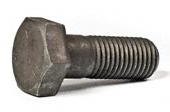Threaded Bolts - Stress Area
Threaded bolts tensile stress area.
The weakest points in a bolt is the stressed area in the thread root. The stressed area depends on the type of threads - coarse threads reduces the stressed area compared to fine threads.

UN and UNR Bolts Tensile Stress Area
The stressed area in a bolt can be calculated as
A = (π / 4) (dn - 0.9743 / n)2 (1)
where
A = stressed area (in2)
dn = nominal bolt diameter (in)
n = 1 / p = number of threads per inch
p = pitch, length per thread (in)
Despite that a reduced area will reduce the breaking load of a bolt - coarse threads are used for clamping. Fine threads bolts are weaker due to the reduced thread height.
ISO 898 Bolts Tensile Stress Area
Tensile stress area in bolts according ISO 898-1 Mechanical properties of fasteners made of carbon steel and alloy steel:
As,nom = (π / 4) ((d2 + d3) / 2)2 (2)
where
As,nom = nominal stress area (m, mm2)
d2 = the basic pitch diameter of the external thread according ISO 724 ISO general-purpose metric screw threads -- Basic dimensions (m, mm)
d3 = d1 - H / 6 = the minor diameter of external tread (m, mm)
d1 = the basic minor diameter of external thread according ISO 724
H = the height of the fundamental triangle of the thread according ISO 68-1 ISO general purpose screw threads (m, mm)
Materials
Most bolts are made of medium or low carbon steel. Forges bolts are called "black" and machined bolts are called "bright". Other materials used are high tensile steel (HT bolts), stainless steel, alloy steel, brass and other materials.
Threads are formed by cutting or rolling.



